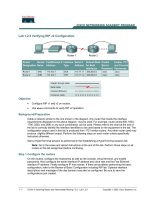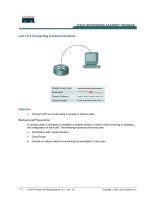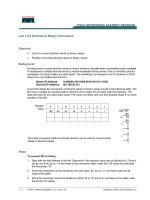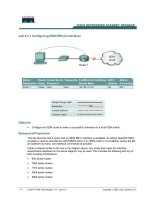Tài liệu Lab 11.2.3b VTY Restriction docx
Bạn đang xem bản rút gọn của tài liệu. Xem và tải ngay bản đầy đủ của tài liệu tại đây (251.04 KB, 3 trang )
Lab 11.2.3b VTY Restriction
Objective
Use the access-class and line commands to control telnet access to the router.
Scenario
The company home office in Gadsden (GAD) provides services to branch offices such as the
Birmingham (BHM) office. Only system with in the local network should be able to telnet to the
1 - 3 CCNA 2: Routers and Routing Basics v 3.0 - Lab 11.2.3b Copyright 2003, Cisco Systems, Inc.
router. To do this standard access-list will be created that will permit users on network the local
network to telnet to local router. The access-list will then be applied to the Virtual Terminal (vty) lines.
Step 1 Basic Router Interconnection
a. Interconnect the routers as shown in the diagram.
Step 2 Basic Configuration
a. The router may contain configurations from a previous use. For this reason, erase the startup
configuration and reload the router to remove any residual configurations. Using the information
previously in the tables, setup the router and host configurations and verify reachablilty by
pinging all systems and routers from each system.
b. Then telnet from the hosts to both the local router and the remote router.
Step 3 Create the Access List that Represents the Gadsden LAN
a. The Local Area Network in Gadsden has a network address of 192.168.1.0 /24. To create the
access list to permit this use the following commands:
GAD(config)#access-list 1 permit 192.168.1.0 0.0.0.255
Step 4 Apply the Access List to Permit Only the Gadsden LAN
a. Now that the list is created to represent traffic, it needs to be applied to the vty lines. This will
restrict any telnet access to the router. While these could be applied separately to each
interface, it is easier to apply the list to all vty lines in one statement. This is done by enter the
interface mode for all 5 line with the global config command line vty 0 4.
For the Gadsden router type:
GAD(config)#line vty 0 4
GAD(config-line)#access-class 1 in
GAD(config-line)#^Z
Step 5 Test the Restriction
a. Test the functionality of the ACL by trying to telnet host and verify that is to be permitted or
denied as appropriate.
[ ] verify that host 1 CAN telnet GAD
[ ] verify that host 2 CAN telnet GAD
[ ] verify that host 3 CANNOT telnet GAD
[ ] verify that host 4 CANNOT telnet GAD
Step 6 Create the Restrictions for Birmingham Router
a. Repeat the above process to restrict the telnet access to BHM. Thus restriction should allow only
hosts in the Birmingham LAN to telnet to BHM
b. Test the functionality of the ACL by trying to telnet host and verify that is to be permitted or
denied as appropriate.
[ ] verify that host 1 CANNOT telnet BHM
[ ] verify that host 2 CANNOT telnet BHM
[ ] verify that host 3 CAN telnet BHM
[ ] verify that host 4 CAN telnet BHM
2 - 3 CCNA 2: Routers and Routing Basics v 3.0 - Lab 11.2.3b Copyright 2003, Cisco Systems, Inc.
Step 7 Document the ACL
a. As a part of all network management, documentation needs to be created. Capture a copy of the
configuration and add additional comments to explain the purpose to ACL code.
b. The file should be saved with other network documentation. The file naming convention should
reflect the function of the file and the date of implementation.
c. Once finished, erase the start-up configuration on routers, remove and store the cables and
adapter. Also logoff and turn the router off.
3 - 3 CCNA 2: Routers and Routing Basics v 3.0 - Lab 11.2.3b Copyright 2003, Cisco Systems, Inc.









